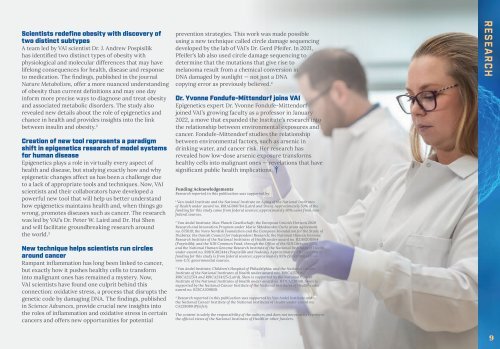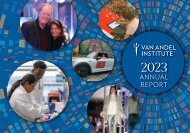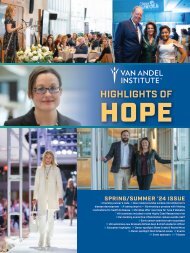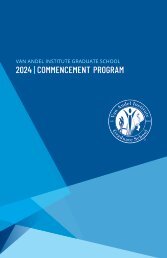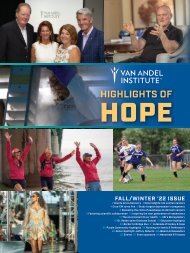2022 Annual Report
This is the 2022 Annual Report for Van Andel Institute.
This is the 2022 Annual Report for Van Andel Institute.
You also want an ePaper? Increase the reach of your titles
YUMPU automatically turns print PDFs into web optimized ePapers that Google loves.
Scientists redefine obesity with discovery of<br />
two distinct subtypes<br />
A team led by VAI scientist Dr. J. Andrew Pospisilik<br />
has identified two distinct types of obesity with<br />
physiological and molecular differences that may have<br />
lifelong consequences for health, disease and response<br />
to medication. The findings, published in the journal<br />
Nature Metabolism, offer a more nuanced understanding<br />
of obesity than current definitions and may one day<br />
inform more precise ways to diagnose and treat obesity<br />
and associated metabolic disorders. The study also<br />
revealed new details about the role of epigenetics and<br />
chance in health and provides insights into the link<br />
between insulin and obesity. 2<br />
Creation of new tool represents a paradigm<br />
shift in epigenetics research of model systems<br />
for human disease<br />
Epigenetics plays a role in virtually every aspect of<br />
health and disease, but studying exactly how and why<br />
epigenetic changes affect us has been a challenge due<br />
to a lack of appropriate tools and techniques. Now, VAI<br />
scientists and their collaborators have developed a<br />
powerful new tool that will help us better understand<br />
how epigenetics maintains health and, when things go<br />
wrong, promotes diseases such as cancer. The research<br />
was led by VAI’s Dr. Peter W. Laird and Dr. Hui Shen<br />
and will facilitate groundbreaking research around<br />
the world. 3<br />
New technique helps scientists run circles<br />
around cancer<br />
Rampant inflammation has long been linked to cancer,<br />
but exactly how it pushes healthy cells to transform<br />
into malignant ones has remained a mystery. Now,<br />
VAI scientists have found one culprit behind this<br />
connection: oxidative stress, a process that disrupts the<br />
genetic code by damaging DNA. The findings, published<br />
in Science Advances, provide crucial new insights into<br />
the roles of inflammation and oxidative stress in certain<br />
cancers and offers new opportunities for potential<br />
prevention strategies. This work was made possible<br />
using a new technique called circle damage sequencing<br />
developed by the lab of VAI’s Dr. Gerd Pfeifer. In 2021,<br />
Pfeifer’s lab also used circle damage sequencing to<br />
determine that the mutations that give rise to<br />
melanoma result from a chemical conversion in<br />
DNA damaged by sunlight — not just a DNA<br />
copying error as previously believed. 4<br />
Dr. Yvonne Fondufe-Mittendorf joins VAI<br />
Epigenetics expert Dr. Yvonne Fondufe-Mittendorf<br />
joined VAI’s growing faculty as a professor in January<br />
<strong>2022</strong>, a move that expanded the Institute’s research into<br />
the relationship between environmental exposures and<br />
cancer. Fondufe-Mittendorf studies the relationship<br />
between environmental factors, such as arsenic in<br />
drinking water, and cancer risk. Her research has<br />
revealed how low-dose arsenic exposure transforms<br />
healthy cells into malignant ones — revelations that have<br />
significant public health implications.<br />
Funding Acknowledgements<br />
Research reported in this publication was supported by:<br />
1<br />
Van Andel Institute and the National Institute on Aging of the National Institutes<br />
of Health under award no. R01AG066764 (Laird and Shen). Approximately 50% of the<br />
funding for this study came from federal sources; approximately 50% came from nonfederal<br />
sources.<br />
2<br />
Van Andel Institute; Max Planck Gesellschaft; the European Union’s Horizon 2020<br />
Research and Innovation Program under Marie Skłodowska-Curie grant agreement<br />
no. 675610; the Novo Nordisk Foundation and the European Foundation for the Study of<br />
Diabetes; the Danish Council for Independent Research; the National Human Genome<br />
Research Institute of the National Institutes of Health under award no. R21HG011964<br />
(Pospisilik); and the NIH Common Fund, through the Office of the NIH Director (OD),<br />
and the National Human Genome Research Institute of the National Institutes of Health<br />
under award no. R01HG012444 (Pospisilik and Nadeau). Approximately 5% ($50,000) of<br />
funding for this study is from federal sources; approximately 95% ($950,000) is from<br />
non-U.S. governmental sources.<br />
3<br />
Van Andel Institute; Children’s Hospital of Philadelphia; and the National Cancer<br />
Institute of the National Institutes of Health under award nos. R01CA157918,<br />
R01CA212374 and R01CA234125 (Laird). Shen is supported by the National Cancer<br />
Institute of the National Institutes of Health under award no. R37CA230748. Jones is<br />
supported by the National Cancer Institute of the National Institutes of Health under<br />
award no. R35CA209859.<br />
4<br />
Research reported in this publication was supported by Van Andel Institute and<br />
the National Cancer Institute of the National Institutes of Health under award no.<br />
CA228089 (Pfeifer).<br />
The content is solely the responsibility of the authors and does not necessarily represent<br />
the official views of the National Institutes of Health or other funders.<br />
RESEARCH<br />
727<br />
9


